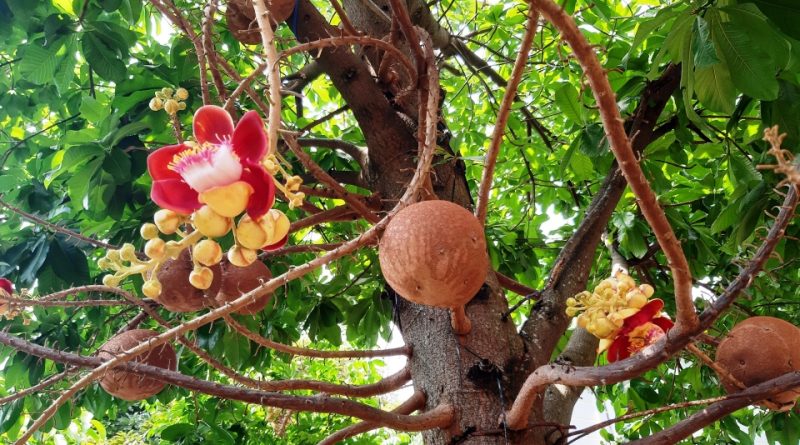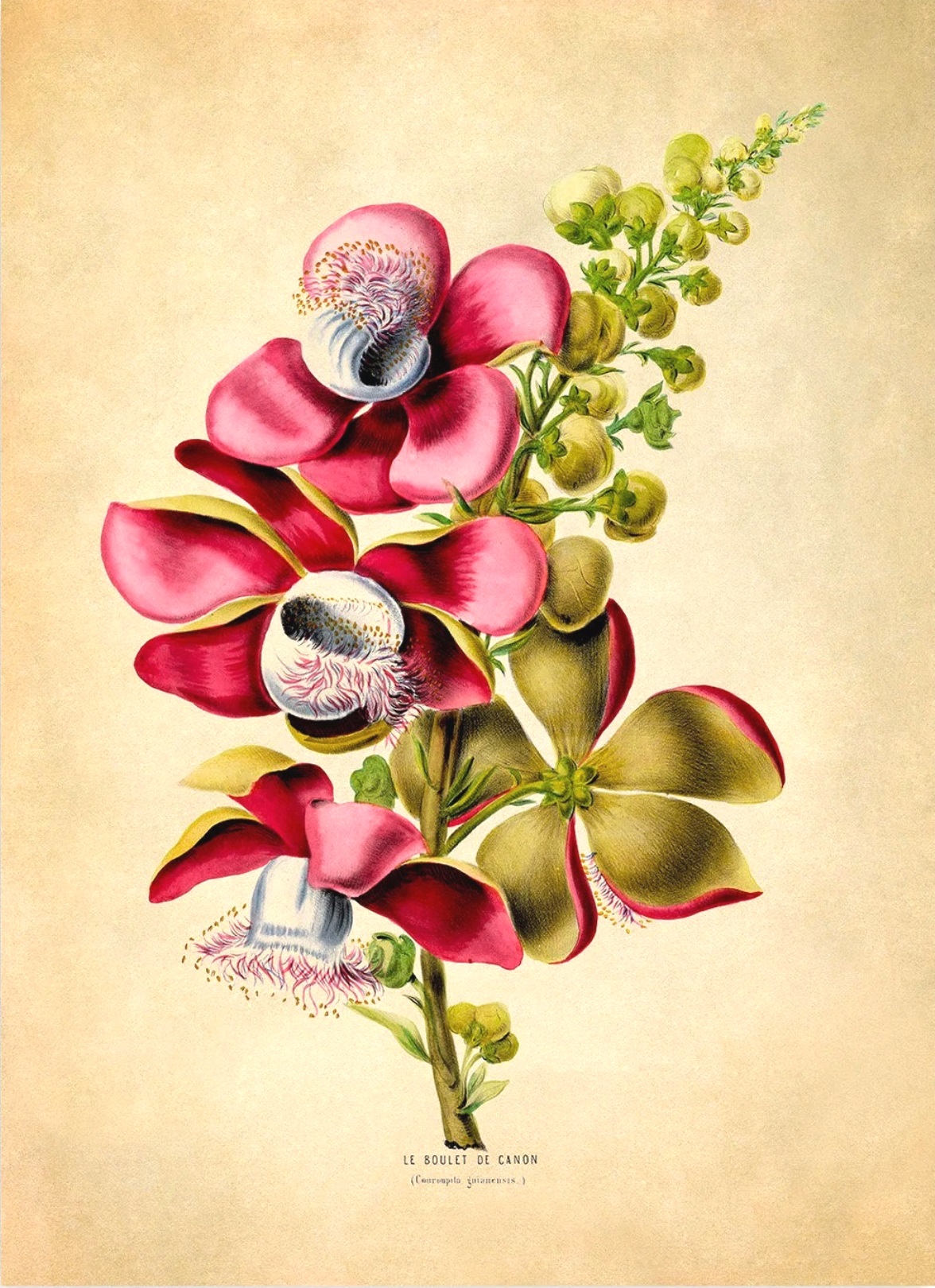Couroupita guianensis
Couroupita guianensis
The cannonball tree (Couroupita guianensis Aubl., 1755) is an arboreal species belonging to the Lecythidaceae family.
Systematic –
From a systematic point of view it belongs to:
Eukaryota domain,
Kingdom Plantae,
Division Magnoliophyta,
Class Magnoliopsida,
Subclass Dilleniidae,
Infraclass Eudicotyledons,
Superorder Asterids,
Ericales Order,
Lecythidaceae family,
Genus Couroupita,
Species C. guianensis.
The terms are synonymous:
– Couratari pedicellaris Rizzini;
– Couroupita acreensis R.Knuth;
– Couroupita antillana Miers;
– Couroupita froesii R.Knuth;
– Couroupita guianensis var. surinamensis (Mart. ex Berg) Eyma;
– Couroupita idolica Dwyer;
– Couroupita membranacea Miers;
– Couroupita peruviana O.Berg;
– Couroupita saintcroixiana R.Knuth;
– Couroupita surinamensis Mart.;
– Couroupita surinamensis Mart. ex Berg;
– Couroupita venezuelensis R.Knuth;
– Lecythis bracteata Willd.;
– Pekea couroupita Juss.;
– Pekea couroupita Juss. ex DC..
Etymology –
The term Couroupita is its vernacular, indigenous name of French Guiana, coming from Couroupitoutoumou.
The specific epithet guianensis is related to its place of origin.
Geographic Distribution and Habitat –
Couroupita guianensis is an evergreen tropical tree native to tropical Central and South America (Brazil, Colombia, Costa Rica, Ecuador, Guyana, French Guiana, Panama, Peru, Suriname and Venezuela).
Its natural habitat is that of the rainforests of Central America and South America where it grows in dense humid forests, often along rivers, at low altitude; in Peru it grows at altitudes lower than 500 meters.
It is also cultivated in many other tropical areas because of its large, fragrant flowers and large, attractive fruits.
Description –
Couroupita guianensis is an evergreen or semi-evergreen tree that can reach a height of about 35 meters and with a dense and oblong foliage.
The stem is cylindrical, with a diameter that can exceed 70 cm and the bark is brownish grey, slightly cracked longitudinally.
The leaves are grouped at the apex of the branches, they are alternate, ovate or lanceolate with an entire or slightly toothed margin, 10-20 cm long and 4-10 cm wide, of an intense green colour.
The flowers arise in racemes up to 80 cm long. Some trees produce so many flowers that the trunk is entirely covered with them; a tree can produce up to 1000 flowers a day. The flowers are intensely scented, especially at night and early in the morning. Their diameter can reach up to 6 cm, they have six petals and colors ranging from shades of pink to red near the base, to yellowish towards the ends. The stamens are located in two areas: a ring of stamens in the center and a group of stamens that have changed into a kind of hook. Even though the flowers lack nectar, they are very attractive to bees, who visit them for pollen. The flowers produce two types of pollen: fertile from the stamens of the ring, sterile from the hook-like structure. The flowers are also pollinated by large tropical bats.
The fruits are spherical in shape with a woody shell and reach a maximum diameter of 25 centimeters. The smaller ones can have up to 65 seeds, but the larger ones can have up to 550 seeds. A tree can have up to 150 fruits, which can take more than a year to ripen (up to 18 months). When fruits fall to the ground, they often do so with a loud, “explosive” noise. They almost always split, allowing animals to feed on the pulp and thus disperse the seeds. Fruits that remain whole can only be broken by animals such as peccaries.
Cultivation –
Couroupita guianensis is a tree that is sometimes harvested in the wild for local use as a food, medicine, and source of materials.
It is a very ornamental tree, especially when it is covered in flowers or large fruits that produce on the trunk.
It is one of the most curious and ornamental trees, the trunk of adult specimens can be covered by flowers and fruits, present at the same time, the flowers last only one day, but are produced in succession and in large numbers. This tree is mostly used as a botanical curiosity in large parks and gardens, taking care to avoid places of passage and parking due to the danger of the heavy fruits which can fall at any time.
There is in fact the disadvantage that large and heavy fruits, which have a bad smell, can cause accidents when they fall from the tree.
It is a plant very sensitive to frost where it can tolerate exceptional drops in temperature up to -1 °C for a very short period.
To be cultivated it prefers a sunny position. In nature it is a plant that loves moist to wet soils, although it can also be successful on dry soils.
Although in nature it lives on almost permanently humid soil, sometimes flooded, it also adapts to markedly seasonal climates, enduring dry periods.
As for pollination, although the flowers lack nectar, they are very attractive to bees, which come for the pollen. Flowers produce two types of pollen: fertile pollen from the ring-shaped stamens and sterile pollen from the cap structure. Pollinators must make their way between the two areas of stamens as they collect pollen. The Xylocopa Brasilerum bee is a common pollinator of cultivated trees in Rio de Janeiro, just outside the tree’s native range. Other bees such as Xylocopa frontalis, as well as wasps, flower flies and bumblebees are also known to visit flowers.
Propagation normally occurs by seed; the seed should be sown as soon as possible after harvesting, it does not require pre-treatment. The seeds can be sown in partial shade, both in flowerbeds and in individual containers.
When using fresh seeds, a germination rate above 80% usually occurs within 8-15 days.
Seedlings should be placed in individual containers when they reach 6-10cm in height and are ready to plant when they are 7 months old.
In nature the seeds are dispersed by animals that feed on the fruits. When fruits fall to the ground, the hard, woody shell usually splits open, exposing the pulp and seeds. Fruits that remain whole can be opened by animals such as peccaries. Many animals feed on the pulp and seeds, including peccaries, pacas, chickens and domestic pigs. The seeds are covered in trichomes which can protect them as they pass through the animals’ digestive systems.
Customs and Traditions –
The tree was first named Couroupita guianensis by the French botanist Jean Baptiste Christophore Fusée Aublet in 1755.
This plant is known by various common names, including: cannonball-tree (English); abricot sauvage, arbre à bombres, arbre à boulet de canon (French); abricó-de-macaco, abricoteiro-de-macaco, amêndoa-dos-andes, castanha de macaco, curupita, macacarecuia (Portuguese – Brazil); bala de canón, bola de canón, coco de mono, granadillo de las huaca, mamey hediondo, maraco, mucus, palo de paraíso, palo santo, taparo de monte (Spanish); kanonenkugelbaum (German).
The tree is often confused, by Hindus and Buddhists of South East Asia, with the Shorea robusta (in Thai: สาละ – salà) the tree under which the Buddha died.
Take into consideration the place of origin of the plant (south-central Americas), discovered by Columbus (1492 AD) and the date of the death of the Buddha (486 BC), not to mention Hinduism. It is logical to assume that the plant could not have been found in the Indian subcontinent approximately 2,000 years before the discovery of the American continent.
In fact, the tree, in addition to being sacred for the indigenous people of the Amazon, has also become so among the Hindus and is planted in the temples dedicated to Shiva in India.
For this reason, in India, the tree is sacred to Hindus, who believe that its hooded flowers resemble nāga under which the white stigma resembles a Lingam, and therefore it is grown in Shiva temples. The tree has since been planted at Buddhist and Hindu religious sites in Asia in the belief that it is the tree of holy scriptures. In Sri Lanka, Thailand and other Buddhist countries Theravada has been planted in Buddhist monasteries and other religious sites
The fruit of this plant is edible but is generally not eaten by people because it can have an unpleasant odor. However, it is used by humans as fodder for domestic animals.
It has been used to treat high blood pressure, tumors, pain and inflammation, the common cold, stomach pain, skin diseases and wounds, malaria, and toothache, although data on its effectiveness is lacking. .
All parts of the plant are used in traditional medicine. The woody outer shell (exocarp) of the fruit is locally used as a container, the upper part of the fruit comes off easily as a lid, and for decoration.
Among other uses, remember that the flowers have a wonderful scent and can be used to perfume perfumes and cosmetics.
The hard shells of the fruit are sometimes used as containers.
The heartwood is light yellow in color; it is not clearly delimited by the sapwood. The texture is medium to coarse; straight or intertwined grain; there is an unpleasant smell from the green wood. The wood is light to very light; very soft to soft; not durable, being sensitive to fungi, woodworms and termites. The maturation is rather slow, with slight risks of cracking or distortion; once dry it is moderately stable in service. The wood is easily worked with common tools, even if it has a tendency to be woolly and to obtain a good finish, stuccoing is advisable; nailing and screwing are poor; the gluing is correct. Wood is used for a variety of lower-value purposes, including toys, boxes and cages, matches, interior joinery and paneling, furniture components, wood goods, floats, lathboard and fiberboard.
From an ecological point of view, Couroupita guianensis is very widespread, but it is not common anywhere. The habitat of this species has largely declined due to logging for settlement, lumbering and agriculture, resulting in populations becoming nationally threatened. The Panamanian subpopulation is limited to a few trees in two provinces. The plant is classified as “Least Concern” in the IUCN Red List of Threatened Species (2013).
Preparation Method –
Couroupita guianensis is a plant that produces fruits whose pulp is edible and sometimes locally consumed, but the smell discourages its use as food, except for animals.
In medicinal use, wood pulp is used, after exposure, in the treatment of animal skin diseases.
The fruit pulp and seeds are ingested as a refreshment.
Additionally, wood is used which is processed for various purposes and items of lower value, including toys, boxes and cages, matches, interior joinery and panelling, furniture components, wooden items, floats, lathboard and fiberboard.
Guido Bissanti
Sources
– Acta Plantarum – Flora of the Italian Regions.
– Wikipedia, the free encyclopedia.
– GBIF, the Global Biodiversity Information Facility.
– Useful Tropical Plants Database.
– Conti F., Abbate G., Alessandrini A., Blasi C. (ed.), 2005. An annotated checklist of the Italian vascular flora, Palombi Editore.
– Pignatti S., 1982. Flora d’Italia, Edagricole, Bologna.
– Treben M., 2000. Health from the Lord’s Pharmacy, Advice and experiences with medicinal herbs, Ennsthaler Editore.
Photo source:
– https://inaturalist-open-data.s3.amazonaws.com/photos/117761728/original.jpg
Attention: Pharmaceutical applications and food uses are indicated for informational purposes only, they do not represent in any way a medical prescription; we therefore decline any responsibility for their use for healing, aesthetic or food purposes.


